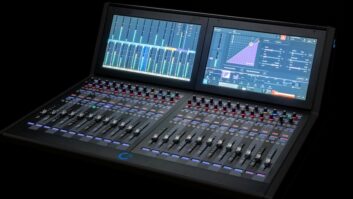Summary: Last year, veteran A1 Florian Brown spent a full day at Florida-based Full Sail University talking to students about what it’s like to work as an A1 and the benefits of working in the broadcast audio. His talk covered many of the different freelance possibilities in audio, video, EVS, editing and more.
Brown began working as an A1 in 1995 and over the past 17 years, his career has led him to work on high-profile events such as the US Open (Tennis) where he worked as an audio supervisor. He’s also worked on Wimbledon, the Australian Open and the ABC NFL Football draft. He’s been using Calrec consoles for the duration of his career and during his time at Full Sail, he had a Calrec Artemis console on hand to show the students what it would be like to work on an audio mixing console that’s so prevalent in broadcast.
1. Tell us a little bit about yourself: How did you get started in professional audio?
My father was a freelance A1. He started at a news affiliate in Cleveland and then became the Audio Guarantee for Laclede Communications. But they struggled to find A1s so he mixed most of the shows himself. He then went freelance in 1988. I joined the Army and went to nursing school to become a licensed nurse practitioner. Once I got out of the service, nursing no longer appealed to me, so my father suggested I go down and work as a utility in his field. I was putting up ice mics on my first day. The rest is history.
2. How long have you been working in the broadcast industry and more specifically as an A1?
I started in the field in 1995 working as a utility and I was quickly promoted to A2. By 1998, a couple of the regular A1s moved out of town and the local crewer asked if I would be interested. I asked if taking the role would mean more work? Little did I know it was the start of what has been a wonderful and fulfilling career for me.
3. What are some major projects/broadcasts you’ve recently worked on and/or are currently working on?
I mix a lot of tennis including Wimbledon and the Australian Open. I’m one of the Audio Supervisors at the US Tennis Open. I also currently mix a lot of golf – US Open, TPC Sawgrass, British Open, and the Ryder/Presidents Cup. I mixed last year’s pre-game Super Bowl show and the ABC NFL Draft. I even mixed the Indy 500 back in the day. I’ve worked on almost every sport.
4. What are the highlights of being an A1? What makes the job exciting and why is it a good professional path?
The best part of being an A1 is never knowing just how your day is going to unfold. Some days are easy, some days are more challenging, but it’s always interesting and it’s certainly never boring! You get a real jolt of exhilaration every time you go live, plus a real sense of accomplishment after the show.
5. Tell us about the talk you gave at Full Sail University. How did it come about?
I was asked by Chris Fichera, VP of Group One (Calrec’s US partner) if I would be interested in explaining the profession to some younger minds. I live in Tampa and Orlando, where Full Sail is, so just a short drive, so it seemed like a no brainer. We just discussed all the different opportunities and how easy it is to jump into the business.
6. Why did Full Sail University decide to do this education session with you?
I have worked with a couple of Full Sail graduates. I helped their careers, so Vincent Lepore, (Full Sail University’s former Director, Event Technical Operations), heard of me through them and thought it would be good to get an experienced operator in to discuss the business. I was immediately intrigued at the idea and very happy to take this on.
7. What topics did you cover in your education session?
We covered all the different “freelance” positions available in audio, video, EVS, editing and more. We discussed what traits the crewing department and bosses on site are looking for. I made it clear to the students that punctuality and a good attitude are first and foremost.
8. We understand you did some demos/tutorial on the Calrec Artemis console. What did you show the students and why did you choose the Artemis for this? What were the benefits to the students for you to use the Artemis?
There were over 40 people in the audience, I wanted to show them that what an A1 does isn’t much different from show to show and sport to sport. You can set up a loose default and that then becomes the bones for almost every sports broadcast. The idea was to take some of the magic and mystery out of the process. Calrec is the premier console for American sports and the Artemis, specifically, is widely used in this industry. It is prevalent in the industry and it made sense to use the audio console that I think students will encounter the most in their careers. Afterwards, lots of people had questions. I think they appreciated hearing from someone actually working in the business with almost two decades of experience.
9. What was the overarching goal of the event? What was your aim?
Sports broadcasting needs new, young, fresh talent. The problem is that not many folks know that these professions exist. You also don’t have to travel 250 days a year to be successful.
10. How familiar are you with Calrec’s technology?
Last year, I took a trip to Hebden Bridge in the UK where Calrec is headquartered, but I have been using their technology ever since I started mixing. Calrec consoles are some of the best in the business. They are clean, easy to use and incredibly reliable.
11. What are your top five tips for young people who want to get started in professional audio and eventually become an A1? What advice would you give them?
My first piece of advice is to have a positive attitude. Being an A1 is a people-facing job and there’s no room for negativity. Always be on time and when you commit to a show, you absolutely need to show up. The business doesn’t forgive no-shows easily. Another piece of advice is to start familiarizing yourself with audio GUIs like Dante, AzEdit, Waves, and Unity. Also, it’s no secret that IP is the way of the future; think about networking and IP management. Last but not least, I also suggest visualizing what you want for your future. Have a plan about where you want to be and what you want to do. Think about six weeks from now, six months and even three years down the line. What events do you want to be working on and how do you plan to get there? As an example, if you want to work on the Super Bowl, a great way to do that is to start working in college football first.
12. How can the industry make broadcast audio more attractive and draw young people (especially women) to the field?
It’s about communicating about this wonderful field and talking about it more because I just don’t think a lot of people know about it. You get to be the boss and play the music you like. Especially now with all the newer technology, it’s exciting to be at the tip of the spear with all the innovations.
13. Where do you recommend that students or anyone new in the field go to learn about professional audio and the ins and outs of being an A1?
Full Sail University is obviously a great place to start. They have most of the gear we currently use in the field. But I truly believe there is no experience better than just getting on a crew — either as a cable puller or runner. Then when someone doesn’t show up or gets sick, the TV compound is the first place they look for the next person to step up.







